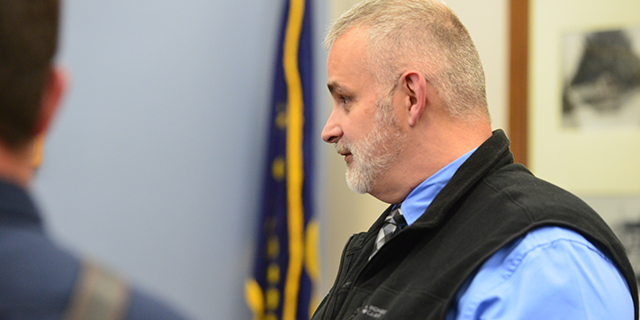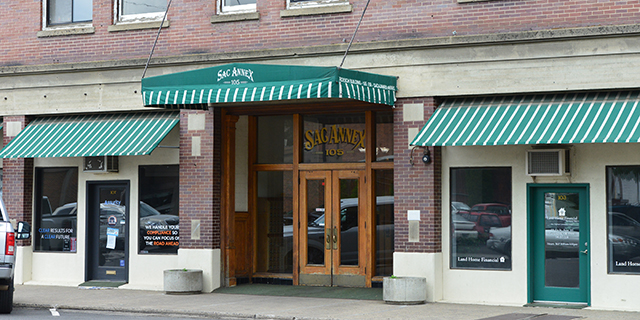Oregon’s college-going rates have fallen, risking equity, the state economy
Published 7:00 pm Wednesday, June 5, 2024

- Francisco Jose Gutierrez Jr. stands in his third grade classroom with other graduating seniors who attended May Roberts Elementary School in Ontario.
ONTARIO — Francisco Jose Gutierrez Jr. always figured he’d make it across the Ontario High graduation stage. But it wasn’t until this spring that Gutierrez decided he might continue with his education after earning a diploma.
Trending
High school in Ontario, on Oregon’s border with Idaho, started poorly for Gutierrez. Like the other 46,000 students across the state who entered ninth grade in the fall of 2020, he was relegated to start the year in online classes after Oregon closed schools during the pandemic.
Gutierrez failed most of his classes freshman year, then did the bare minimum to get by when he returned as a sophomore. Junior year started strong, but a wave of trouble at home, including the death of his dog, a relative’s serious illness and his parent’s separation, again derailed his academics.
Gutierrez figured he’d jump straight from high school into working construction, a trade he learned from his dad.
Trending
But senior year brought new focus, and Gutierrez put dramatically more effort into school. In the last few months, he’s begun to lay the groundwork for college, applying to the nearby community college and submitting a federal financial aid form that defeated many of his peers. He plans to begin classes in the fall.
In many ways, he’s defying trends.
Fewer Oregon high school graduates are going to community colleges or universities, data shows. Gradual declines since 2017 were supercharged by the pandemic. College-going fell to just 56% for the class of 2021, a nearly 10 percentage point drop over the last decade.
Even before COVID-19, there was a worrisome downturn in enrollment emerged among rural boys. Researchers who analyzed the class of 2019 found young Latino males like Gutierrez were among the least likely to go — only 29% of rural Latino males went straight to college that year.
College-going declines have played out coast to coast, but Oregon saw a starker drop than the nation overall. Economists and education officials say this is troublesome news for equity and for the economy.
As the pandemic receded, Oregon’s college and university enrollments have inched upward, a possible indicator that college-going will show improvement for the graduating classes of 2022 and 2023. But disastrous upheaval with the Free Application for Federal Student Aid this year has higher ed watchers worried about another college-going setback for the class of 2024.
The federal aid application is a crucial tool for students to learn how much help they might get from colleges, scholarships and governments to pay for school. Completing it is one key barometer of a student’s likelihood of enrolling in college.
Nationwide, completions are 14% down from last year. Through May 24, just over a third of Oregon high school seniors had turned theirs in, according to a national tracker, 12% fewer than the year before.
“The delay in aid packages almost certainly will depress college enrollments overall. How much? Nobody knows. This is unprecedented territory,” said Josh Wyner, director of the College Excellence Program at The Aspen Institute, a global nonprofit that focuses on improving economic and education policies, among others.
Trained workforce needed
Decreases in college-going are a troubling trend for Oregon’s economy, said John Tapogna, who specializes in education for Portland-based economic consulting firm ECONorthwest.
Work is becoming increasingly complicated as jobs demand more interaction with technology, Tapogna said. As Oregon expands its advanced manufacturing and semiconductor sectors, many of those jobs are going to require education beyond a high school degree. Oregon community colleges offer a bevy of short-term career certificates and credentials, many of which focus on industries and skilled trades.
“I don’t claim to say that everybody needs a bachelor’s or a master’s or a Ph.D. but some amount of training beyond high school to get a little bit more specific in your skills,” Tapogna said.
The state doesn’t aspire to have every graduating high schooler earn a degree or credential, let alone earn one right away.
Its ambitious 40-40-20 goal, set in 2011, instead aims for 80% of Oregonians ages 25 to 34 to hold a postsecondary credential of some sort by 2025. Half would earn a bachelor’s or higher and the other half some kind of associate degree, certificate, apprenticeship or other postsecondary training.
That’s not going to happen.
As of 2021, the most recent figure available, 56% of young adult Oregonians held a postsecondary credential. Bachelor’s degree attainment is nearly at 40%, but fewer than 20% of young people had earned an associate or career credential. And college-going has fallen steeply at the two-year institutions poised to help people earn that quick training.
Oregon’s public universities enrolled about 18% of the state’s high school graduates from the class of 2021, down about 3 percentage points from the share they enrolled in 2014, while community colleges experienced a 7 percentage point drop. Public two-year colleges still serve the largest share of college-goers; 27% of the class of 2021 started at a community college.
“This isn’t just a community college issue, it’s not even just a higher ed issue,” said Elizabeth Cox Brand, director of the Oregon Student Success Center for community colleges. “This is a workforce issue. This is our tax base. We’ve got to be creating more individuals who are getting living wage jobs for their families so that we can continue to grow our economy.”
States, high schools and the nation as a whole rely on a single source to measure college-going rates: a nonprofit called the National Student Clearinghouse. It receives information about students at nearly every U.S. public and private institution of higher education, allowing it to track which students enroll. It tracks 97% of all higher ed enrollments, with private trade schools accounting for most of the data it does not capture.
Oregon does track enrollment in some private career schools, however. That data shows they enrolled just a sliver of the state’s young adults. Although those numbers have risen over the past five years or so, they still amount to only about 850 people in a given high school graduating class.
National Student Clearinghouse reports show Oregon’s overall college-going rate fell by 8 percentage points in two years once the pandemic hit.
For students of color except Asian Americans, the decline was even worse, widening existing college-going gaps.
Postsecondary enrollment declined most severely over the last decade for Oregon’s small population of Pacific Islander students, only 37% of whom in the class of 2021 enrolled in college within 16 months of graduation. They also fell drastically for Oregon’s Black and Indigenous students.
Oregon’s Latino students, who were growing their propensity for college enrollment as most groups declined, saw that progress wiped out during the pandemic.
For Oregon’s Higher Education Coordinating Commission, which aims not only to increase college-going but to shrink racial and ethnic disparities, that represents a “disturbing and distressing” trend, Amy Cox, the agency’s research director, told commissioners last fall.
Senior year turnaround
It was a teacher who first helped Gutierrez, who many call Junior, think of college as an option.
Carren Poff first had Gutierrez in her English class as a sophomore. He was sweet, she remembers, but like the rest of that sophomore class, still learning the ropes of high school, a year late. Gutierrez would space out, she said, and needed constant redirection to help focus. She worried whether she was going too fast or that he wasn’t getting enough sleep.
She’d catch glimpses of good classwork and pull him aside for pep talks.
‘”You can do this,’” she’d tell him. “And I don’t know if he felt like he could do this.”
Gutierrez returned to Poff’s class as a senior, changed. He was proactive about talking with her and checking his work, and he was explaining assignments to his peers and helping them stay on track. He was silly, she said, but in an endearing way.
The turnaround was prompted by heartache, Gutierrez said. During his junior year, Gutierrez’s grandma got sick and one of his favorite dogs died. He lost his car in a crash and his parents split up. Remarkably, instead of giving up on school, he decided to try harder.
“I didn’t want to continue suffering,” he said. “To get better, I had to start trying. I had to put the work in.”
Poff brought in speakers to talk to her senior class about career and college possibilities, Gutierrez said, which got him thinking about next steps.
Poff’s take was that Gutierrez seemed reluctant to start down the college path because he was afraid to fail. Many of this year’s seniors are worried about getting into college, she said, or about starting and then flunking out.
“Her believing in me, schoolwise, it just gave me a confidence boost,” Gutierrez said.
Students question payoff
High school students are questioning the value of a college degree in a way they weren’t 10 years ago, Patrick Methvin, director of postsecondary success at the Bill & Melinda Gates Foundation, told reporters on a call this March.
Juniors and seniors across the country grapple with the financial trade-offs of going to college and worry they’ll make the wrong choice about their futures, June 2023 research by the foundation found.
In dozens of interviews around the state, Oregon’s seniors echoed that. They’re terrified of getting buried in debt and many don’t understand the nuances of the financial aid available to them. The sticker price of attending Oregon universities shocks some students out of even applying.
“They’re making a decision: This is really expensive, I’m not sure what I’m going to get out of it, I don’t really know what I want to do, so I’m just going to go on to work,” said Jon Kilzer, a school counselor at Ontario High.
College is particularly expensive in Oregon. Tuition and fees at Oregon’s public universities, at an average of $13,440, are the most expensive of 15 West Coast states. Oregon community colleges’ average, at $6,464, is second only to South Dakota.
When adjusted for inflation, the cost of attending college in Oregon has risen 38% over the past two decades and students have increasingly shouldered that burden as state investment fluctuates.
Teresa Alonso Leon, a former state lawmaker involved in setting education policy, said that Oregon is decades behind in funding postsecondary education. Adjusted for inflation, per-student state spending on higher education is up just 4% from 1980 and down 4% from where it was in 2001.
“How are we creating access and removing barriers if we as a state have not prioritized post secondary higher education in a very long time?” she asked.
Military enlistment, one option for graduates, is also on the decline. Recruiters fielded interest from about 1,950 Oregonians ages 17 to 19 in 2023, up slightly from the height of the pandemic, but well below the 2,275 young people who showed interest in 2019, according to the U.S. Military Entrance Processing Command. Oregon National Guard recruitment is also down.
Nationally, shrewd high schoolers said they see more value in on-the-job training and courses to receive a license or a professional certificate than in two- or four-year degrees, the Gates Foundation reported.









